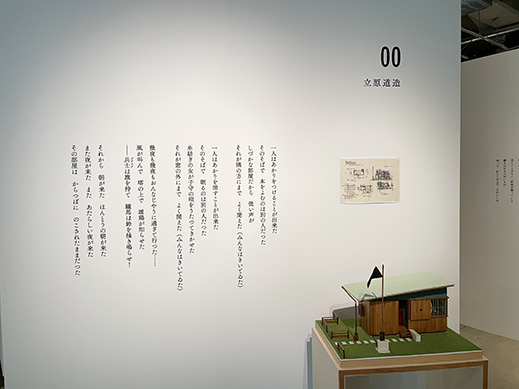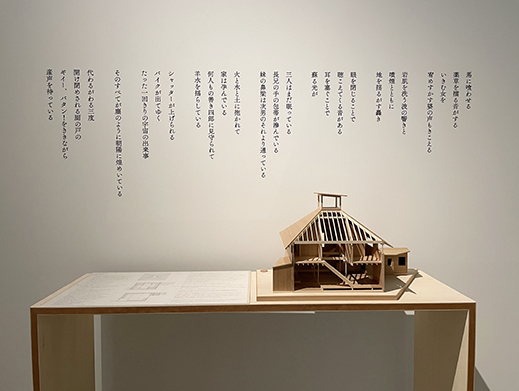 |
Focus features two in-depth reviews each month of fine art, architecture, and design exhibitions at art museums, galleries, and alternative spaces around Japan. |
|
|
 |
 |
 |
Crossing Paths: A Collaborative Exploration between Writer and Architect
James Lambiasi |
 |
Installation view of The Words for Architecture at WHAT.
Photo: Kenji Seo
|
Architects express themselves through visual tools. Plan drawings organize spatial layouts, computer graphics render perspective views, and physical models show built form. Writers, on the other hand, conjure images and feelings by crafting words. The Collectors' Museum of Contemporary Art "WHAT" (which stands for Warehouse of Art Terrada) explores the nature of both forms of expression in its current exhibition, The Words for Architecture, by crossing the paths of writers and architects through the juxtaposition of houses and literary works. A special exhibition by the Archi-Depot Project, it introduces 15 house projects, each accompanied by a literary work devoted to expressing the essence of the dwelling itself. The creative act of building is represented by study models, sketches, blueprints, and videos, and this is reinterpreted for us though the expressive vision of writers.
 |
|
Model and sketch of Hyacinth House (1938) by Michizo Tachihara, accompanied by his own poem. Photo: James Lambiasi
|
An exhibit of note is a small cabin by Michizo Tachihara; he was both an architect and a poet, and has provided the original inspiration for this exhibition. We are greeted by his sketches and a recreated model of his Hyacinth House alongside his poem, which describes daily existence in a small room -- in other words, evoking images of dwelling. Tachihara's promising career was sadly cut short when he passed away at the young age of 24 in 1939, which sets a poignant tone as it reminds us that life is brief, and buildings eventually disappear, but words have permanence.
Santiniketan House (2018) exhibit by Kengo Sato, accompanied by a poem by Nilanjan Bandyopadhyay. Photo: James Lambiasi
|
Interior model of Santiniketan House by Kengo Sato; scale: 1/20 (2017). Photo: © In-Field Studio
|
As this type of collaboration between writer and architect is in many ways unprecedented in its approach, it is worthwhile to reflect on the revealing perspective it can provide. While many architectural exhibitions frequently satisfy our need to see the most contemporary buildings, and we voraciously consume the objects and forms, this exhibition focuses on existing houses that have been lived in for years. Perhaps one could express it as a chance to pause and contemplate the act of dwelling, and realize that the spaces that envelop our daily lives and the memories created there are the most important aspect of producing a building. Through the works of the 15 different literary artists who wrote about the experiences of dwelling in these houses, we have the enriching opportunity to view both the role of writer and architect in a new light.
 |
|
 |
|
|
|
|
Poem by Kei Okamoto floating on the floor space of the exhibit of Tamagawagakuen House (1998) by Toshihiro Tanaka. Photo: James Lambiasi
|
|
Model of Holes in the House, Fuminori Nousaku / Mio Tsuneyama; scale: 1/10 (2017). Photo: James Lambiasi |
The poems and literary works are all in Japanese, so as a struggling expat I was quite appreciative that English translations are provided in a separate handout. The spirit of the exhibition is abundantly clear in the way it allows us to see both poetry and architecture as similar art forms, each able to evoke images and emotion. For example, from my own perspective as an architect, one aspect of this collaboration that caught my attention is the inventiveness in the display of the poems -- on the walls, on the floor, floating on loose pages. Just as the material of a model or the scale and medium of a drawing can be critical in conveying the meaning of a building, the way in which the poems occupied the space felt integral to their overall meaning, resulting in the sensation of being enveloped within the space of words.
Please also note that included with the entry fee for this exhibition is access to another exhibition at WHAT, Inside the Collector's Vault, Vol.1. That exhibition features about 70 works by two collectors, Ryutaro Takahashi and another who remains anonymous. The collection of the latter consists of exhibits by Yoshitomo Nara, so if you are a fan of his works, this should definitely not be missed.
 |
|
Model of Shinoie (2020) by Naoya Mishina and Asuka Mishina, accompanied by a poem by Yasuhiro Yotsumoto. Photo: James Lambiasi
|
All images by permission of WHAT. |
 |
 |
James Lambiasi
Following completion of his Master's Degree in Architecture from Harvard University Graduate School of Design in 1995, James Lambiasi has been a practicing architect and educator in Tokyo for over 26 years. He is the principal of his own firm James Lambiasi Architect, has taught as a visiting lecturer at several Tokyo universities, and has lectured extensively on his work. James has served as president of the AIA Japan Chapter in 2008, and frequently appears on the NHK series "Journeys in Japan" as an architectural critic. |
|
 |
|